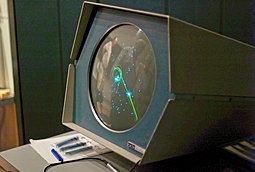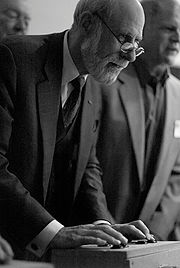Spacewar!
From Wikipedia, the free encyclopedia
| This article includes a list of references or external links, but its sources remain unclear because it lacks inline citations. Please improve this article by introducing more precise citations where appropriate. (October 2007) |
|
Spacewar!
|
|
|---|---|
 |
|
| Developer(s) | Steve Russell et al. |
| Platform(s) | PDP-1 |
| Release date(s) | 1962 |
| Genre(s) | Space combat simulation, Shoot 'em up |
| Mode(s) | Two players, simultaneously (only) |
Spacewar! is one of the earliest known digital computer games.
Steve "Slug" Russell, Martin "Shag" Graetz and Wayne Wiitanen of the fictitious "Hingham Institute" conceived of the game in 1961, with the intent of implementing it on a DEC PDP-1 at the Massachusetts Institute of Technology. After Alan Kotok obtained some sine and cosine routines from DEC, Russell began coding, and by February 1962 had produced his first version. It took approximately 200 hours of work to create the initial version. Additional features were developed by Dan Edwards, Peter Samson and Graetz.[1]
Contents |
[edit] Gameplay

The basic gameplay of Spacewar! involves two armed spaceships called "the needle" and "the wedge" attempting to shoot one another while maneuvering in the gravity well of a star. The ships' fired missiles were unaffected by gravity (due to a lack of processing time). Each ship had a limited number of missiles and a limited supply of fuel.The hyperspace feature could be used as a last-ditch means to evade enemy missiles, but the reentry from hyperspace would occur at a random location and there was an increasing probability of the ship exploding with each use.
Each player controls one of the ships, and must attempt to simultaneously shoot at the other ship and avoid colliding with the star. Player controls included clockwise and counterclockwise rotation, thrust, fire, and hyperspace. Initially these were controlled using the front-panel test switches, with four switches for each player, but these proved to wear out very quickly under normal gameplay. Most sites used custom control boxes wired into the same switches, although joysticks and other inputs were also used.
[edit] Options and features

Early versions of the game contained a randomly generated background starfield. However, the inaccuracy and lack of verisimilitude annoyed Samson, so he wrote a program based on real star charts that scrolled slowly: at any one time, 45% of the night sky was visible, every star down to the fifth magnitude. The program was called "Expensive Planetarium" (referring to the price of the PDP-1 computer), and was quickly incorporated into the main code.
There were several optional features controlled by sense switches on the console:
- no star (and thus no gravity)
- enable angular momentum
- disable background starfield
- the "Winds of Space"- a warping factor on trajectories that required the pilot to make careful adjustments every time he moved
Spacewar! was a fairly good overall diagnostic of the PDP-1 computer and Type 30 Precision CRT Display, so DEC apparently used it for factory testing and shipped PDP-1 computers to customers with the Spacewar! program already loaded into the core memory; this enabled field testing as when the PDP was fully set up, the field representative could simultaneously relax and do a final test of the PDP.
Spacewar! was extremely popular in the 1960s, and was widely ported to other systems. As it required a graphical display, most of the early ports were to other DEC platforms like the PDP-10 or PDP-11, or various CDC machines.
[edit] Spacewar! today
As of May 2006[update], there is only one working PDP-1 known to be in existence, at the Computer History Museum in Mountain View, California. The computer and display were completely restored after two years of work, and Spacewar! is operational. On selected days at the Museum, visitors on the PDP-1 tour get a chance to play Spacewar! first hand.
A second PDP-1 belonging to the Computer History Museum is currently on tour as part of the Game On exhibition, previously shown at the Barbican in London. However, this PDP-1 is not operational.
On May 15, 2006, the museum presented The Mouse That Roared: A PDP-1 Celebration Event.[2] The PDP-1 was demonstrated running Spacewar! as well as other programs, and members of the public were able to play the game using makeshift controllers. Further PDP-1 demonstrations will be scheduled on a biweekly basis on Saturday afternoons.
Most recently, Spacewar! code has been given out with Microsoft XNA Game Studio Express.[3]
[edit] Games inspired by Spacewar!
Over the years, many computer games have been inspired by Spacewar! [4] ; some are known by the same name. Some are straightforward clones, but most have introduced additional variations to the game play, such as:
- various rates of acceleration
- various levels of gravity (even negative)
- missiles affected by gravity
- fuel (energy) regeneration over time
- shields
Arcade versions of Spacewar! were released as the Galaxy Game (1971), Computer Space by Nutting Associates (1971), and Space Wars by Cinematronics (1977), the last being the most commercially successful.
The first networked version of this genre was Orbitwar (1974) by Silas Warner on the PLATO network. It included all the features of the original Spacewar! with the addition of a Big Board where PLATO users would await challenges from each other to play.
Home versions have appeared for most computer and console systems, with some becoming quite elaborate, such as the Star Control series, introducing a wide variety of gameplay frameworks around the basic one-on-one combat system at its core. Senko no Ronde can be described as a modern interpretation of Spacewar!, with a design heavily inspired by versus fighters such as Street Fighter II. The Escape Velocity series also owes its 2D inertial combat and navigation to Spacewar!.
Non-space themed variants with similar play (ie two players control a vehicle using similar controls - ie rotate left / rotate right / move forward / fire - and try to score by hitting their opponent with a missile) include Tank by Kee Games and Combat by Atari.
Although some accounts mistakenly identify Spacewar! as a motivation for the development of Unix, the game involved in that case was Space Travel.[5]
Atari made two Spacewar games. Space War was an Atari 2600 port that had many additional options added to it. They were also in the works of an Atari Jaguar videogame that was named Spacewar 2000 as a major 3D update to the original. It got cancelled when Atari abandoned the system's support after Fight for Life.
[edit] Earlier computer and video games
The first graphical computer game is believed to have been OXO (a Tic-tac-toe game), developed by A.S. Douglas in 1952. William Higinbotham built Tennis for Two in 1958 using discrete analog hardware rather than a program for a digital computer.
[edit] See also
[edit] References
- Levy, Steven (1984). Hackers: Heroes of the Computer Revolution. Anchor Press/Doubleday. ISBN 0-385-19195-2.
- Brand, Stewart (1974). II Cybernetic Frontiers. Random House. ISBN 0-394-49283-8.
- Graetz, J.M., The Origin of Spacewar, in Creative Computing, August 1981, pp. 56-67.
[edit] Notes
- ^ Markoff, John (June 3rd 2006). "Alan Kotok, 64, a Pioneer In Computer Video Games". The New York Times Company Staff. The New York Times. http://query.nytimes.com/gst/fullpage.html?res=9E0CE0DB1731F930A35755C0A9609C8B63. Retrieved on February 5th 2009.
- ^ "The Mouse That Roared: A PDP-1 Celebration Event". http://www.computerhistory.org/events/index.php?id=1142978073. Retrieved on 2008-08-01.
- ^ Cox, Charles and Klucher, Michael (May 2007). "Unleash Your Imagination With XNA Game Studio Express". MSDN Magazine (Microsoft Corporation). http://msdn.microsoft.com/msdnmag/issues/07/05/XNA/default.aspx. Retrieved on 2007-10-04.
- ^ Markoff, John (December 16th 1990). "Digital Fetes the 'Germ' That Began a Revolution". The New York Times. NYtimes.com. http://query.nytimes.com/gst/fullpage.html?res=9C0CE2D91430F935A25751C1A966958260. Retrieved on February 5th 2009.
- ^ Ritchie, Dennis M.. "Space Travel: Exploring the solar system and the PDP-7". http://cm.bell-labs.com/cm/cs/who/dmr/spacetravel.html. Retrieved on 2007-03-11.
[edit] External links
- Spacewar! page at the Computer History Museum
- History of Spacewar!
- The original Spacewar! code running on PDP-1 emulator in Java
- Dmoz directory for Spacewar!
- 1up.com's article naming Spacewar! the most important video game ever made
- "Spacewar", a 1972 Rolling Stone article by Stewart Brand
- A 1972 Saga Magazine article about Spacewar!
- Computer and Video Game History describes Spacewar! and earlier video games such as A.S. Douglas' Tic-Tac-Toe and William Higinbotham's Tennis for Two




